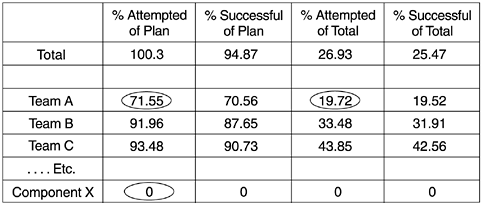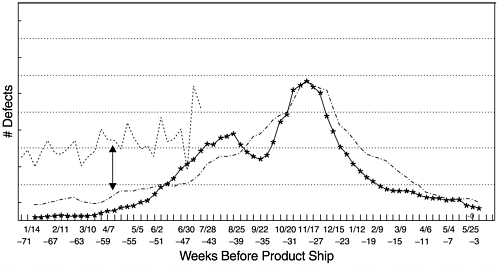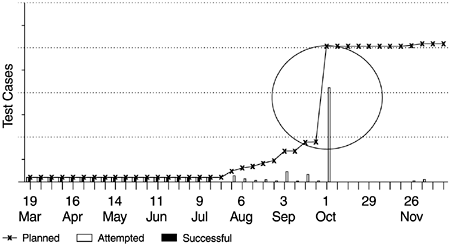The Evaluation Phase
You figured out which data are important to look at and now you are ready to analyze and evaluate them. This is when one can apply all possible data analysis and statistical techniques to extract the messages within it.
15.2.1 Quantitative Data
For quantitative analysis tools such as control charts, trend charts , histograms, pareto diagrams, and scatter diagrams or statistical techniques ranging from simple tabulation analysis to sophisticated multivariate methods are all fair game. It is our experience that simple techniques can be very powerful and most of the time sophisticated statistical techniques are unnecessary. The key point is to garner useful information from the data. As discussed in previous chapters, we found that using the effort/outcome paradigm is particularly useful in assessing in-process metrics. Of course, the data gathered must include both effort indicators and outcome indicators in order to apply this approach, and this should be a consideration in the planning and preparation phase. At the least, from raw data to useful information, some meaningful comparisons with relevant baseline, plan, or a previous similar product need to take place.
When analyzing the data, it is always good practice to pay particular attention to anything unusual. Good questions to ask in such situations are, "What more can I learn about this?" and "How can I put this into perspective?" Figures 15.3, 15.4, and 15.5 include examples of data that bear further investigation. In Figure 15.3, Team A was significantly behind plan in its functional test and Component X had not even started its testing. In Figure 15.4, the defect arrival pattern of the current project dif-fered from that for previous comparable projects. Was the higher defects volume in the early part of the defect curve due to more effective testing and better progress? Was the testing effectiveness and progress about the same as previous project at this point in the development cycle? In Figure 15.5, the test plan S-curve shows an unusual and potentially unachievable pattern.
Figure 15.3. Data on Functional Tests that Beg for Further Investigation

Figure 15.4. A Defect Arrival Pattern that Deviates from Historical Data

Figure 15.5. A Test Plan S Curve Showing an Unusual Pattern

15.2.2 Qualitative Data
For the qualitative evaluation, information from the interviews and open -ended probing can be classified , grouped, and correlated with existing knowledge and findings from quantitative analyses. The strongest proponents of quantitative methods argue that without metrics, an assessment is just another opinion. While quantitative data is important, our experience indicates that effective quality assessments are characteris-tically based on cross validation of findings and observations of both quantitative data and qualitative evaluation. Expert opinions also carry special weight. To that regard, the assessor should be equipped with acute observations to delineate whether the input he or she is getting is true expert opinion or opinion clouded by other factors. For example, opinions of the quality of the project may be optimistic by the development manager and pessimistic by the testing manager. It is not uncommon that at project checkpoint review meetings, the status of the project goes from excellent to poor, or vice versa, in just a few moments depending on the order of presentations by the development, support, testing, and service groups.
15.2.3 Evaluation Criteria
Evaluation of qualitative data is based on expert judgment and cross validation. For quantitative indicators, you may want to use predetermined criteria to ensure consistency. The following are sample criteria for evaluation of quantitative indicators:
- Green = actual within (<=) 5% behind or better than plan (model or a comparable previous project)
- Yellow = actual is between 5% and (<=) 15% behind plan (model or a comparable previous project)
- Red = actual is greater than 15% behind plan (model or a comparable previous project)
- For some indicators, specific considerations apply. For example, for testing defect arrivals, higher is better at earlier phases. After peaking, lower is better if testing effort is not compromised.
The following are sample criteria for a qualitative indicator (plan change):
- Green = no or small amount of plan changes after the commitment checkpoint of the project. No additional risks involved.
- Yellow = some amount of plan changes after the commitment checkpoint of the project, but not on critical line items of the project. Risks identified and assessed, and plans in place to mitigate and control risks.
- Red = plan changes on critical line items that took place after the project commitment checkpoint put the project at high risk. Assumptions at the commitment checkpoint are no longer valid.
The following shows sample criteria for an indicator that may require both qualitative and quantitative evaluation (design status):
- Green = no major design issues; design review status within (<=) 5% behind or ahead of plan.
- Yellow = design issues identified and plans being put in place to resolve, or design review status between 5% and (<=) 15% behind plan.
- Red = critical, project-gating design issues identified with no plans to resolve, or design reviews behind plan greater than 15%.
What Is Software Quality?
Software Development Process Models
- Software Development Process Models
- The Waterfall Development Model
- The Prototyping Approach
- The Spiral Model
- The Iterative Development Process Model
- The Object-Oriented Development Process
- The Cleanroom Methodology
- The Defect Prevention Process
- Process Maturity Framework and Quality Standards
Fundamentals of Measurement Theory
- Fundamentals of Measurement Theory
- Definition, Operational Definition, and Measurement
- Level of Measurement
- Some Basic Measures
- Reliability and Validity
- Measurement Errors
- Be Careful with Correlation
- Criteria for Causality
Software Quality Metrics Overview
- Software Quality Metrics Overview
- Product Quality Metrics
- In-Process Quality Metrics
- Metrics for Software Maintenance
- Examples of Metrics Programs
- Collecting Software Engineering Data
Applying the Seven Basic Quality Tools in Software Development
- Applying the Seven Basic Quality Tools in Software Development
- Ishikawas Seven Basic Tools
- Checklist
- Pareto Diagram
- Histogram
- Run Charts
- Scatter Diagram
- Control Chart
- Cause-and-Effect Diagram
- Relations Diagram
Defect Removal Effectiveness
- Defect Removal Effectiveness
- Literature Review
- A Closer Look at Defect Removal Effectiveness
- Defect Removal Effectiveness and Quality Planning
- Cost Effectiveness of Phase Defect Removal
- Defect Removal Effectiveness and Process Maturity Level
The Rayleigh Model
- The Rayleigh Model
- Reliability Models
- The Rayleigh Model
- Basic Assumptions
- Implementation
- Reliability and Predictive Validity
Exponential Distribution and Reliability Growth Models
- Exponential Distribution and Reliability Growth Models
- The Exponential Model
- Reliability Growth Models
- Model Assumptions
- Criteria for Model Evaluation
- Modeling Process
- Test Compression Factor
- Estimating the Distribution of Total Defects over Time
Quality Management Models
- Quality Management Models
- The Rayleigh Model Framework
- Code Integration Pattern
- The PTR Submodel
- The PTR Arrival and Backlog Projection Model
- Reliability Growth Models
- Criteria for Model Evaluation
- In-Process Metrics and Reports
- Orthogonal Defect Classification
In-Process Metrics for Software Testing
- In-Process Metrics for Software Testing
- In-Process Metrics for Software Testing
- In-Process Metrics and Quality Management
- Possible Metrics for Acceptance Testing to Evaluate Vendor-Developed Software
- How Do You Know Your Product Is Good Enough to Ship?
Complexity Metrics and Models
- Complexity Metrics and Models
- Lines of Code
- Halsteads Software Science
- Cyclomatic Complexity
- Syntactic Constructs
- Structure Metrics
- An Example of Module Design Metrics in Practice
Metrics and Lessons Learned for Object-Oriented Projects
- Metrics and Lessons Learned for Object-Oriented Projects
- Object-Oriented Concepts and Constructs
- Design and Complexity Metrics
- Productivity Metrics
- Quality and Quality Management Metrics
- Lessons Learned from OO Projects
Availability Metrics
- Availability Metrics
- 1 Definition and Measurements of System Availability
- Reliability, Availability, and Defect Rate
- Collecting Customer Outage Data for Quality Improvement
Measuring and Analyzing Customer Satisfaction
- Measuring and Analyzing Customer Satisfaction
- Customer Satisfaction Surveys
- Analyzing Satisfaction Data
- Satisfaction with Company
- How Good Is Good Enough
Conducting In-Process Quality Assessments
- Conducting In-Process Quality Assessments
- The Preparation Phase
- The Evaluation Phase
- The Summarization Phase
- Recommendations and Risk Mitigation
Conducting Software Project Assessments
- Conducting Software Project Assessments
- Audit and Assessment
- Software Process Maturity Assessment and Software Project Assessment
- Software Process Assessment Cycle
- A Proposed Software Project Assessment Method
Dos and Donts of Software Process Improvement
- Dos and Donts of Software Process Improvement
- Measuring Process Maturity
- Measuring Process Capability
- Staged versus Continuous Debating Religion
- Measuring Levels Is Not Enough
- Establishing the Alignment Principle
- Take Time Getting Faster
- Keep It Simple or Face Decomplexification
- Measuring the Value of Process Improvement
- Measuring Process Adoption
- Measuring Process Compliance
- Celebrate the Journey, Not Just the Destination
Using Function Point Metrics to Measure Software Process Improvements
- Using Function Point Metrics to Measure Software Process Improvements
- Software Process Improvement Sequences
- Process Improvement Economics
- Measuring Process Improvements at Activity Levels
Concluding Remarks
- Concluding Remarks
- Data Quality Control
- Getting Started with a Software Metrics Program
- Software Quality Engineering Modeling
- Statistical Process Control in Software Development
A Project Assessment Questionnaire
EAN: 2147483647
Pages: 176
